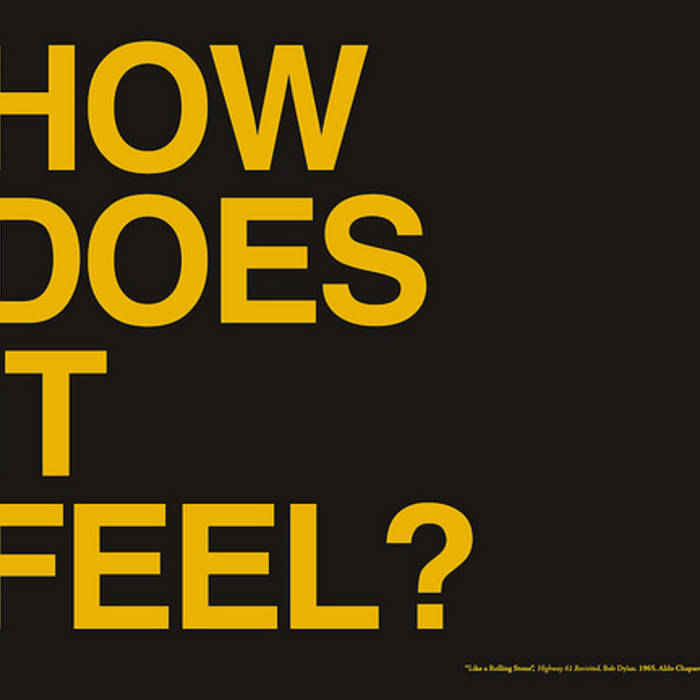How to make an irish dance costume
How I made my own Irish dance Solo dress (on a budget)
This sewing project was a special one. It connected two passions of mine: crafts and Irish Dance. It was also complex and long: I split it in two phases, the first one spanning from Winter to May 2019, the second one from Summer 2019 to the beginning of 2020.
After a few years competing at Irish dancing feiseanna, I decided I wanted to make me a proper Solo dress. If never heard about those kind of dresses, you have to know they are intricated, sparkling, decorated, complicated, and also expensive.
Since my husband and I love making things by ourselves, we planned and sewed it together.
Back in 2019 I didn’t have a sewing machine and my only experience with clothes making was my Medieval gown. As I said, Solo dresses are usually complicated, so we said to ourselves we needed a starting point to make things easier: a dress to modify. We started from a 50’s black dress with the perfect shape, but too long and lacking sleeves.
So the plan was: first round, adding sleeves; second round, taking care of the skirt, that needed to be shorter, fuller and less black; final step, decorating the whole dress. I had a basic idea of what I wanted to accomplish, but a few details changed along the way.
Click for the finished project detailed photos
Jump to section
The design and inspirationsThe making of the dressDecorating my Irish dance Solo dressLet’s sum up!
The design and inspirations
The basic sketch I draw as a template for the making of my own Irish dance Solo dress
Before diving into the making itself, let me explain how I conceived the basic idea and design for my own Irish dance solo dress.
I browsed loads of dresses for inspiration, then drew several ideas on basic templates. The one that came out as the winner, was a compromise between what I desidered and what I thought we could be able to accomplish.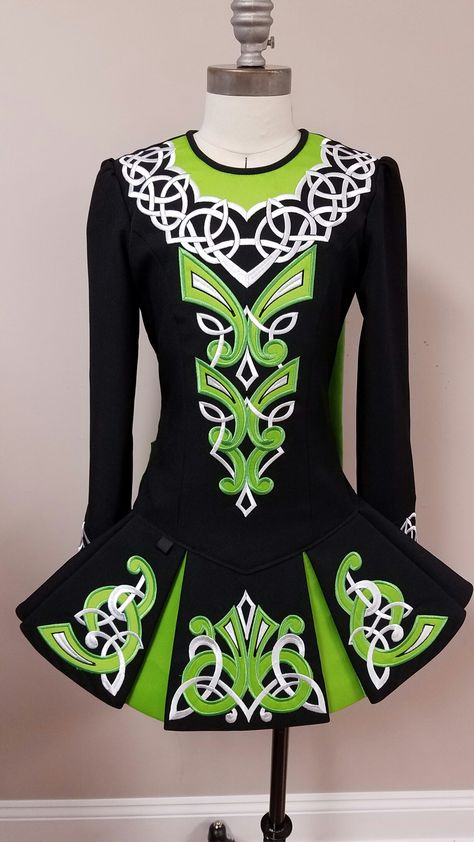
I wanted the dress to be black and emerald green, following the main colors of the skirt we wore at my Irish dance school for beginner solo competitions and team competitions.
Without thinking about the decorations yet, I planned a little collar and skirt with two layers of fabric, the green one emerging from the black one through a series of triangles.
About the sleeves, I drew them in green, while the main body of the dress was black, because I thought finding the perfect matching fabric the exact same color and material would be a tough task. So I decided to make them different from the start.
And just for reference, here I show you the main inspirations I selected for my sketch. Also, a good example of what an Irish dance Solo dress is, for anyone not familiar with them.
I got inspiration for the collar design from a Prime Dress Designs creation. They use this kind of swan-neck collar a lot, and I loved its look.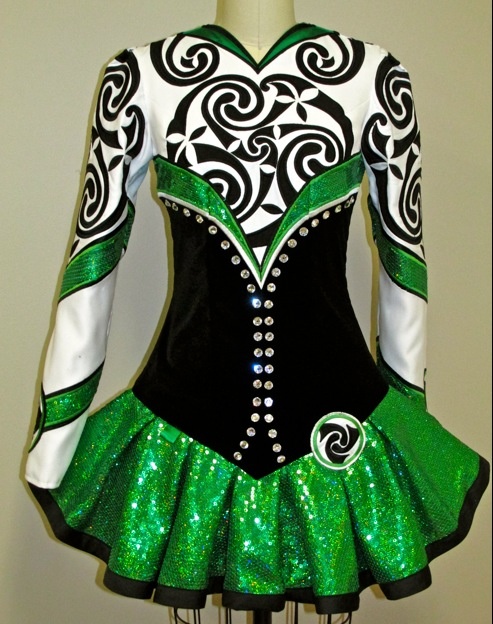
From another of their dresses I picked the idea for the skirt. Well, that’s not a Solo dress, is a school dress, usually worn by members of a team. This skirt has a first layer with cuts, from which it emerges a second layer with a different color. I love this, and I was imagining the effect while dancing.
Also, I found a white and red dress of which I loved the shape of the decorations. On the front there’s a sort of vertical flame decoration that slims the figure a lot. I was thinking about replicating it with embroidery. And a few crystals, since you can’t call Solo dress a dress that has no sparkles!
Some of the Solo dresses around are shinier than a star, but I wanted something more delicate.
Irish dance Solo dress by Prime Dress Designs
The school dress of Slattery School of Irish Dance made by Prime Dress Designs
Irish dance Solo dress by John Carey Design
The making of the dress
To make the sleeves, we first made a pattern with scrap fabric and tried it on the dress.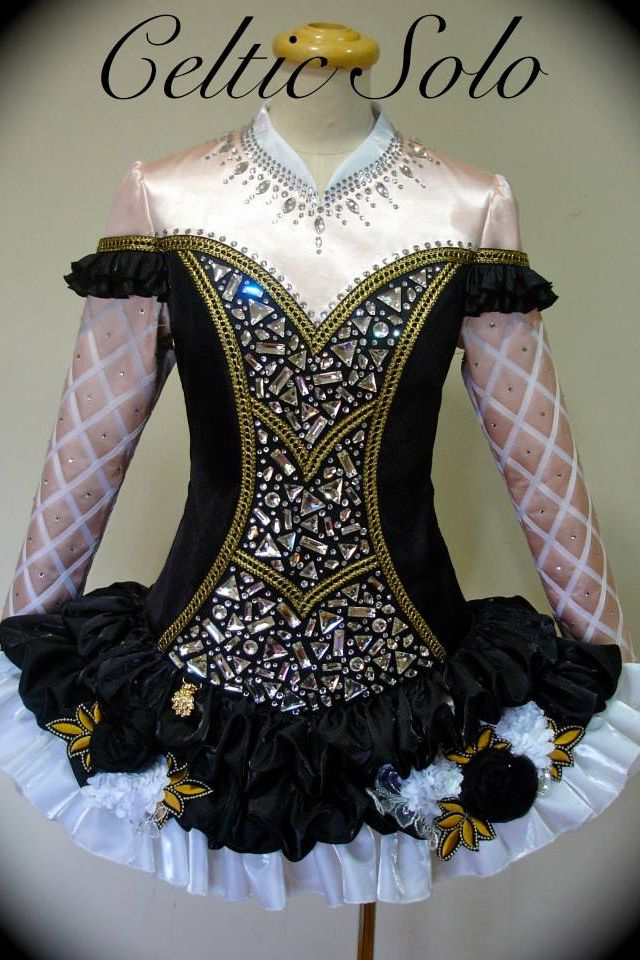 When we did it to make my Medieval gown, it was a really useful step, better than working with paper patterns. Well, this time we were not satisfied with the outcome.
When we did it to make my Medieval gown, it was a really useful step, better than working with paper patterns. Well, this time we were not satisfied with the outcome.
Yes, we knew it would have been the hardest task, but after an evening trying and trying again we almost surrendered, thinking about hiring a proper tailor to make the sleeved for us.
I was beginning to think we wanted to make a project too hard for us, having made just one dress with a 6-months struggle.
Well, the morning after I woke up realising which mistake we were making: we placed the dress on the table and attached the sleeve with a 90° angle! So the following evening we gave it another try, attaching the sleeves with a 45ish° angle and… the sleeves came out perfect! When I saw the sleeves finished I was really thrilled!
We chose a not-so-easy sleeve design, also.
My first plan was to make a basic dress, then decorating it myself with hand-embroidery and appliques.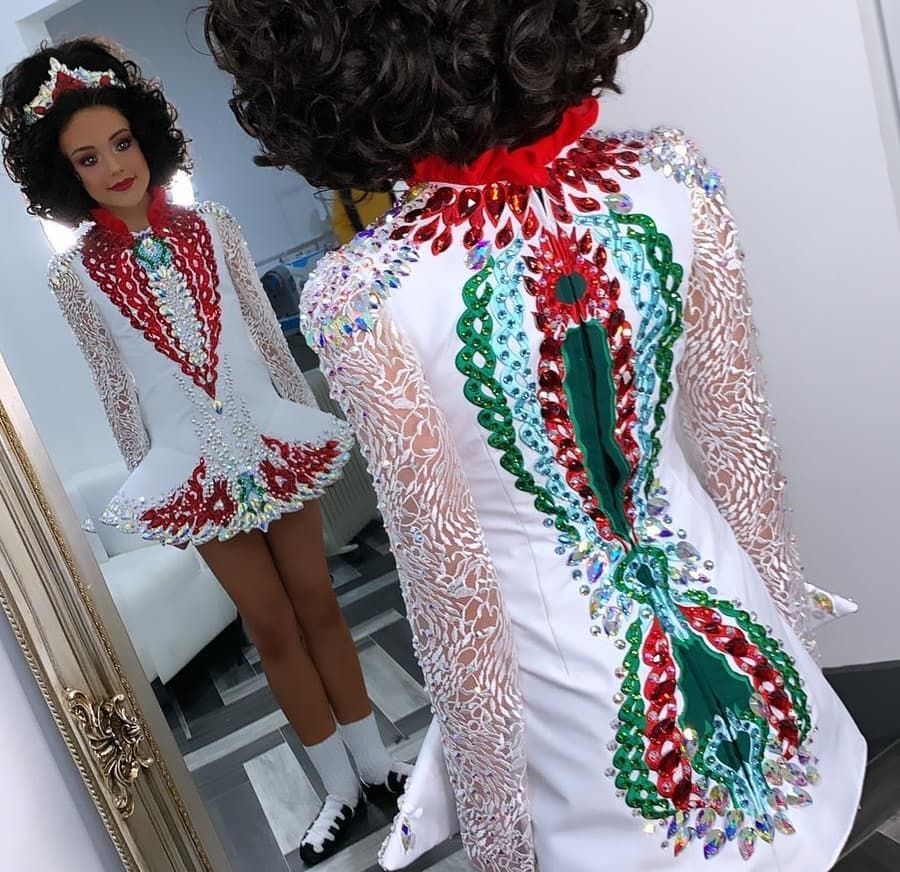 But one day we were browsing our favourite fabric shop for materials and my husband came out with a lovely green lace. The same emerald green I have on my dance school skirt! I fell so in love with it that I completely changed my original design to adapt it to that awesome fabric!
But one day we were browsing our favourite fabric shop for materials and my husband came out with a lovely green lace. The same emerald green I have on my dance school skirt! I fell so in love with it that I completely changed my original design to adapt it to that awesome fabric!
I decided to add black sleeves all covered in that green lace. Then, on the bodice and all the skirt, I wanted to add cut-out pieces of the lace, to form a regular pattern.
So, for the sleeves, we cut two layers, one on in black fabric and one in lace, pinned them together and machine sewed. The advantage was that we could use a light black fabric without having to look for the exact same one that made the main dress, since the lace is the part that stands out.
After attaching the finished sleeves, I picked up needle and thread and began hand sewing all the cuff borders, to fix the lace on the black fabric. It took me a lot of work, but this way I refinished the edges and gave strenght to the whole sleeve.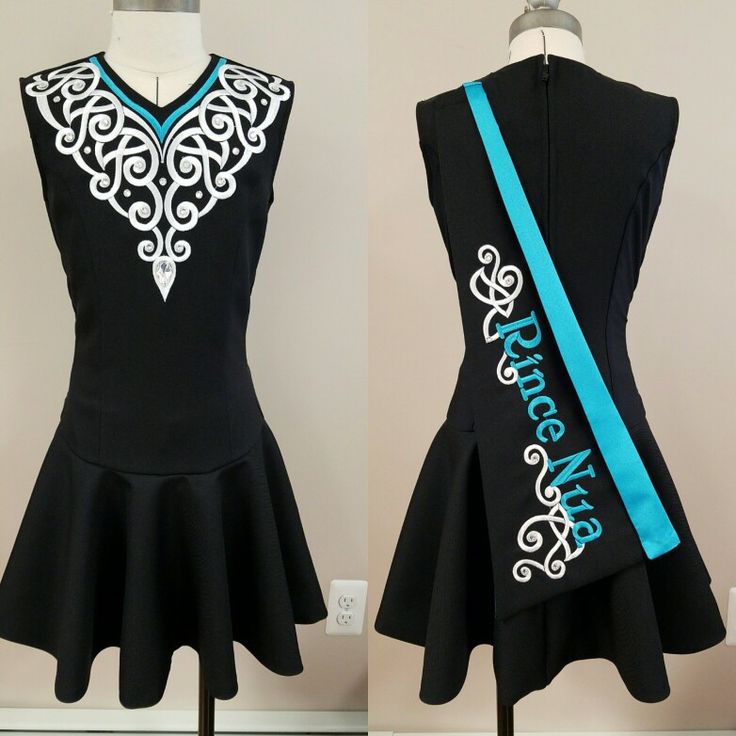
Next step: taking care of the skirt.
First, we made a green tulle underskirt to give volume and width. The beginning was quite complicated, with three layers of fabric to pin together for sewing. Fortunately I’ve a box full of pins!
Each layer was a little shifted down from the previous one, so the waist was thinner than the lower edge, volume increasing progressively.
Layer by layer, with the help of my sister-in-law, I was able to prepare all the pleated tulle layers for my husband, who machine sewed it to their green lining. The lining was paramount, since I have to wear tights and didn’t want them to get stuck to the tulle: I wanted a softer fabric between my legs and the underskirt.
Following that, we had to join the underskirt to the main dress.
The choice about how to join skirt and underskirt was not straightforward.
The first idea was to sew them together along the waist, but then I begun thinking about how to handle the full dress.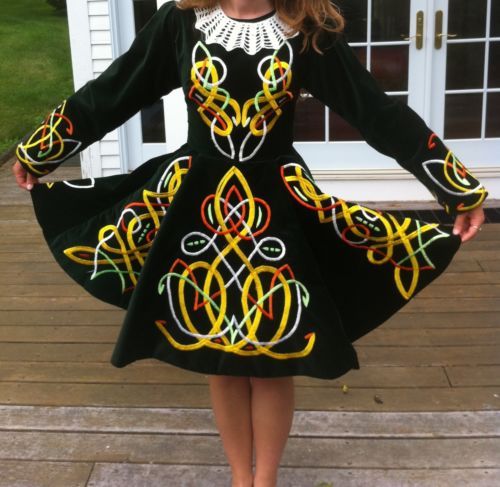 It would certainly be handier with two separated parts, especially when I need to wash it.
It would certainly be handier with two separated parts, especially when I need to wash it.
The question then was: can I secure the underskirt to the dress to make them strongly attached during the dances but easy to separate when needed? In short, the final answer was no. Nor popper buttons or velcro were a good option.
I thought about it a lot, I did researches, asked friends and grannies and, in the end, I dedided the best way to attach them together… was just sewing.
The main issue that made me think a lot about this was the idea of washing the tulle together with the rest of the dress. Well, in the end I decided to set the matter aside and went for the easiest way.
And I’m also happy with the final result because from the outside you don’t see the stitches: I was able to hide them thanks to a thin inner lining the dress has.
Well, the skirt was far from being finished! Next came the part I feared most: cutting!
The dress I chose as a base had a too long skirt for my purpose, so I had to cut.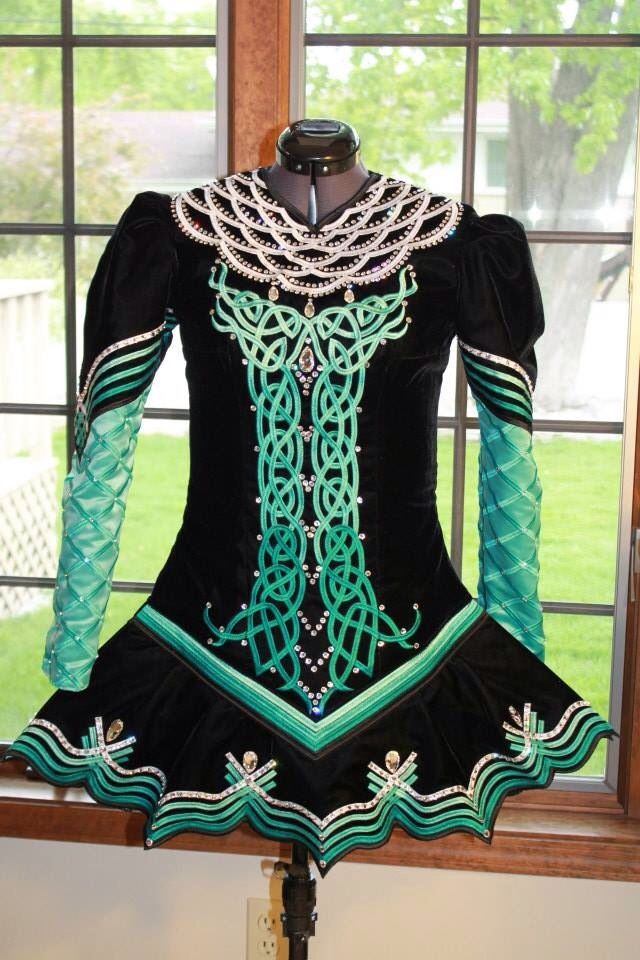 What if I cut too much? What if the final result is not good on me or doesn’t adhere to the competition rules?
What if I cut too much? What if the final result is not good on me or doesn’t adhere to the competition rules?
This is why I first secured the underskirt: to see the real final volume and make a precise cut. I checked the lenght twice, also with the help of my dance teacher and fellow dancers. Even when I made up my mind about the correct lenght, I still feared I could make a mistake and ruin the whole project without repair!
I let my husband do the cut (both of the dress and underskirt with its lining) and, after a lot of worries, we were both satisfied of the result. I even decided it was worth cutting another couple of centimeters, after the first cut. Yes, my husband was right this time: he wanted to cut more from the start!
And, after this cut, I wanted to make things more complicated by adding ten green triangles all around. Not a two-layered skirt with cuts on the top layer as first planned, but a wider one, with colored inserts.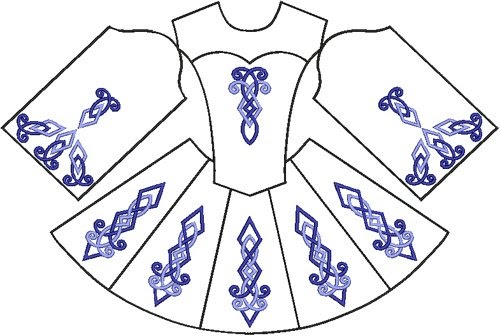
An engineer husband can be useful in ways you can’t suspect! Well, I have to say mine is also the grandson of a seamstress, so he saw a lot about dressmaking in his youth.
We measured ten triangles in green fabric to be added to the black skirt, and all the planning of how to cut and sew was his. First, we made a prototype on scrap fabric, then used it as a pattern.
I carefully basted all of them and loved the outcome! For the machine sewing (mainly because the next dance competition was approaching), we asked my husband’s grandmother for help. She took no time to finish sewing those triangles to my skirt. She also refinished the lenght of the underskirt and lining and sewed the lining hem.
It began to resemble a basic Irish dance dress! But something important was still missing, and that meant my favourite part had come: the decorations!
Decorating my Irish dance Solo dress
When I began the decorations, I literally had to run to be able to wear the dress during the upcoming feis. I wanted to add all the green decors to the bodice and skirt, just to dance at the competition with a dress that wasn’t totally black.
I wanted to add all the green decors to the bodice and skirt, just to dance at the competition with a dress that wasn’t totally black.
Seeing the dress in front of me at that stage, I changed my original mind about handembroidery. I wanted to go on with the same lace used on the sleeves. I love it so much that I thought it wasn’t worth spending endless time with another kind of hand decoration.
So I carefully cut out single pieces of green decorations to add where the dress was too black. I positioned them on the dress, took photos, reexamined them over and over with my husband, changed several times how much I wanted to add and where.
The first goal, just for the competition ahead, was to add a bit of green where it lacked color, then complete the decorations later, after the end of the competition season.
I handsewed all the green lace. And I was more than careful doing that! I strongly stitched every single twist and turn and curl, leaving no place unstitched.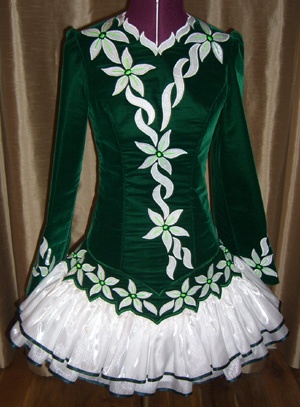 The main goal was to make the dress and its decorations sturdy and strong to resist even the most daring dance.
The main goal was to make the dress and its decorations sturdy and strong to resist even the most daring dance.
Finally, in May 2019 I was able to wear my Irish dance Solo dress for the first time! It was comfortable, it behaved just like I imagined it. And it gave me a more “professional” look next to more traditional dresses than the class skirt and t-shirt I used to wear.
I had time just to sew the green lace to the bodice, I had to leave the skirt all black. Well, I have to say I was glad the work was not finished yet! I enjoyed a lot working on my dress.
It came out quite different from the dress I drew and planned. I renounced the swan collar because my basic dress had a straight neckline, and I did like it in the end. The lace was the main reason my dress came out as it is, and I’m glad I’ve found it at the fabric store.
After the end of the 2019 competition season, I had my plan to finish adding the green lace to the skirt and then adding sparkles.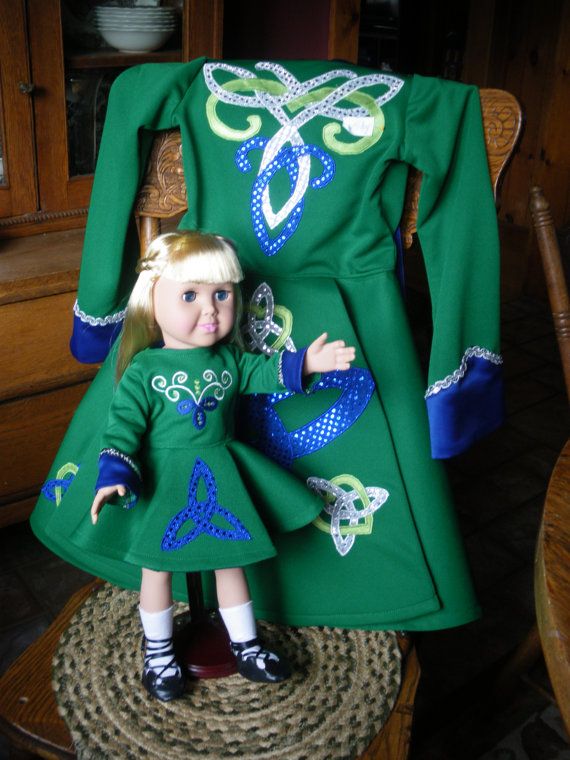 They are so ubiquitous in Irish dance, I couldn’t go without.
They are so ubiquitous in Irish dance, I couldn’t go without.
About the skirt, I had metres and metres of stitching to make to attach the green lace all around. A seemingly endless work! But this is the part I longed for most, so I enjoyed each single step, being careful in all my hand stitching.
My lace had lovely triangular patterns that were perfect to cut-out and the right size to cover the fabric. I chose the triangles close to the lace edge, so I could use its own border to refinish the lower edge of my dress.
I had ten black triangles to cover, about a couple of metres wide in total at the edge, but in the end I decided I liked the skirt with alternate triangles, one black and one with lace. Nonetheless, every single piece of it needed to be strongly attached with resistant stitches, so the task was about three months long!
I stitched all along the edge of the lace, following each single leaf and flower.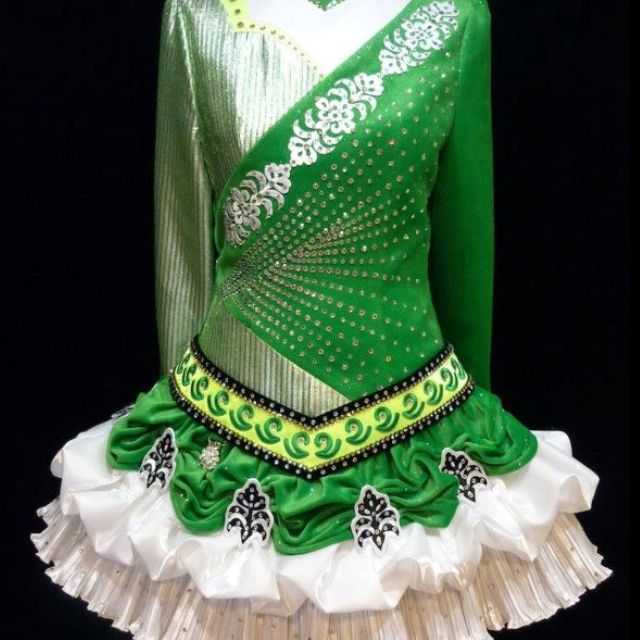 I wanted the decoration to be as sturdy as possible.
I wanted the decoration to be as sturdy as possible.
Besides the long had-stitching, with my husband’s help and the suggestions from my Feis friend Alessia, who was going on with a similar dress project, I was browsing around for sparkles to add all around.
Thinking about sparkles, the new doubt was: should I glue them or sew them?
There’s a whole world behind it I never imagined! Glueing or sewing was just the first choice. I had no idea that such a huge world was behind crystals for dance dresses! With my Feis friend I learnt a lot about sizes, glue, brands, shapes, colors… I quickly felt dizzy!
In the end, I chose the sew on kind: a cabochon with four holes gave me the idea of being more stable.
I went for the classic white crystals, instead of the colored ones. I decided to buy one pack of the SS12 size (3mm), to begin. They were so many to stitch! But I had no fear of the job in hand: that was exactly what I was looking for, a new excuse for hand-stitching!
What I needed to do next, was planning where to place them.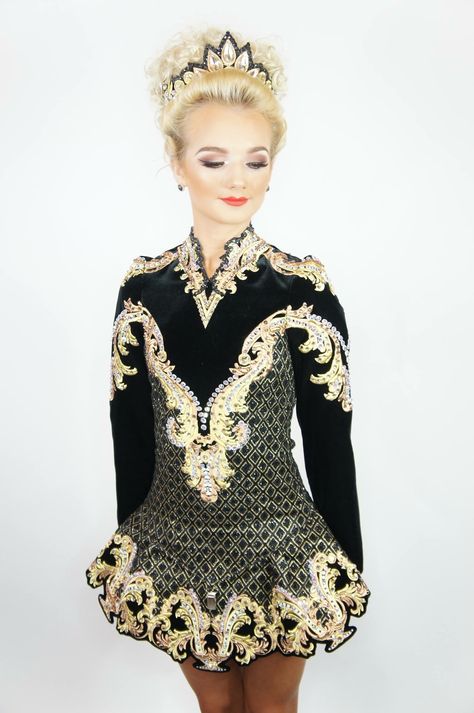
Another long step was awaiting me, I didn’t know if as long as the lace part or even more.
My first idea was to sew them only on the lace, but my husband saidys that, on the sleeves, it would be better if I placed them all around, also on the black fabric.
I tried and I have to say my husband was right. I decided to cover all the sleeves with a uniform grid of sparkles, then sew more on the lace of the skirt. I drew a grid with each rhinestone 8cm apart from the next ones. That was just to begin: I told me that, if I found they were not enough, I could add more in the middle.
At first I thought the sewing would have been harder. The hardest part, mainly at the beginning, was keeping the two fabrics of my sleeve evenly together, to keep the sleeve smooth while adding one crystal after the other. I had to be careful placing each crystal in place and keeping where it was intended to stay.
Also, following a regular grid was not so easy: I had to consider the position of each rhinestone keeping watch of all the surrounding ones, were they already in place or not.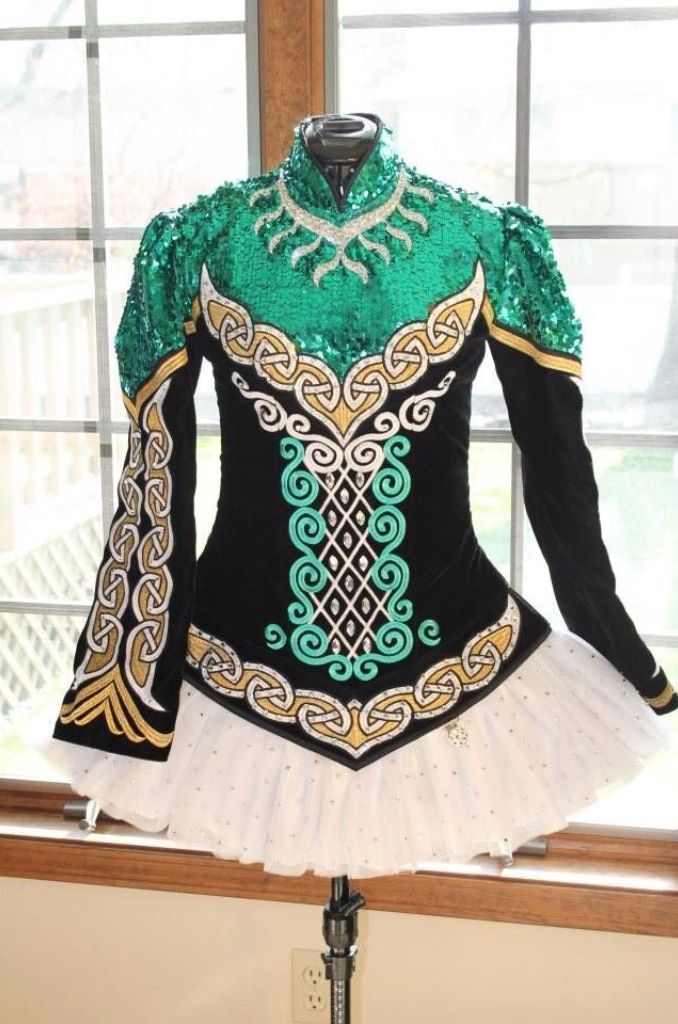
Well, as always, going on with practice makes you quicker and helps a lot finding the right way to complete your work.
After finishing the sleeves, I decided to move on to the skirt. I wanted to see the rhinestones all around the dress before deciding if the quantity was good.
I expected the sewing to be even quicker on the skirt, because I had just one layer of fabric and I didn’t have to plunge into a tight space as the sleeve is. Also, I chose not to stick to a regular grid.
Here the plan was to give each triangle with lace its own touch of sparkle. Then, to refinish the look, I planned to sew sparkles also on the bodice.
Well, as soon as I saw the triangles completed with just 10 crystals each, I thought it better to redouble them. First of all, though, I wanted to refinish the front, so I could have a glimpse of the final look of all the dress.
I knew for certain, at this stage, that I needed to add more crystals everywhere to achieve the effect I was looking for.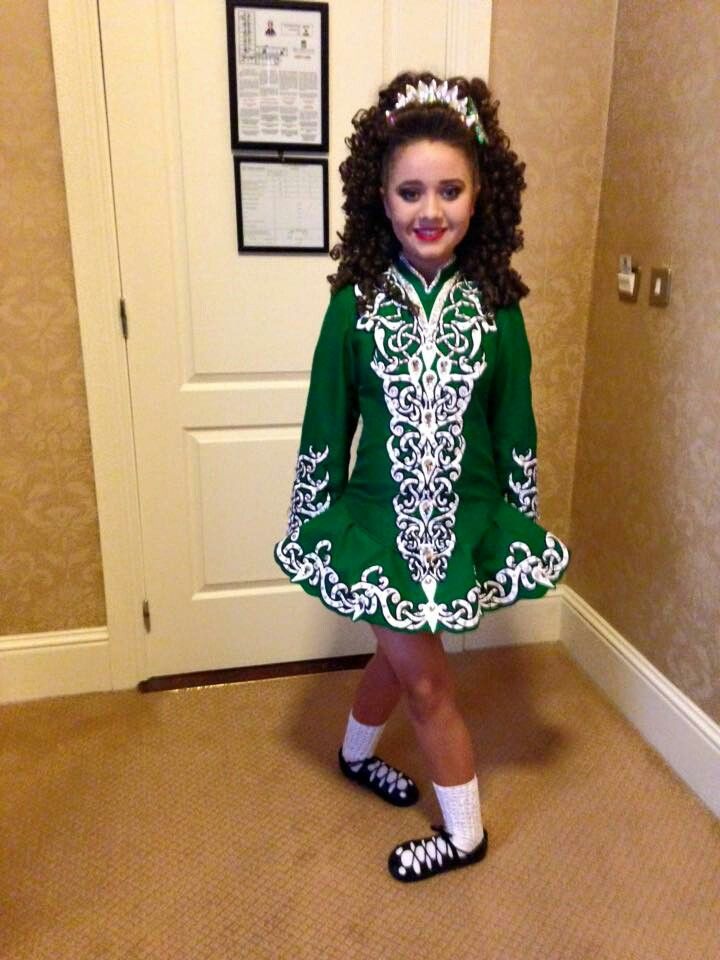
At the end of the crystal sewing on the bodice, I was ready to start over, adding more sparlkes everywhere on my dress.
When I began the sewing, I thought the crystals I planned to use were enough, but the more I went on, the more I saw I needed more. Not too much, though, I have always been careful not to overdo. Paying attention not to exaggerate was better than repenting at the end of a long work.
Let's sum up!
And… after a very long sewing process, my Irish dance Solo dress was finally completed!
Wearing it during the 2019 Busto Feis competition was incredible. I was stunned thinking I was wearing it finished, after a long work that, from start to finish, lasted for a year and a half. Also, I felt at ease among the other dancers, with their colorful and shiny dresses.
That day, after the competition, I decided I didn’t want to add anything else to my dress: for now, I am totally satisfied with the result.
Well, I have to say I’m also sorry the project has finished. It’s been funny and rewarding!
Almost three years after, I sometimes wonder what I would do differently if I had to start over now. I gained more experience with the sewing machine, so I suppose I would go without a basic dress to modify, but I would start from scratch, with just fabric and floss. About the outcome, I would change nothing!
A choice that could be different now? Maybe the main color but… that’s a story for another time!
And you? What do you think about it? Let’s discuss together!
How to Make Irish Dancing Costumes
Stockbyte/Stockbyte/Getty Images
Sewing an Irish dance costume dress requires a lot of time and patience, and it can be a very expensive endeavor. However, with the cost of competition dresses ranging in the hundreds, sewing your own costume could be worth your while if you have enough experience. Before you begin this project, make sure you have a purpose for the dress, be it for competition or a dance recital.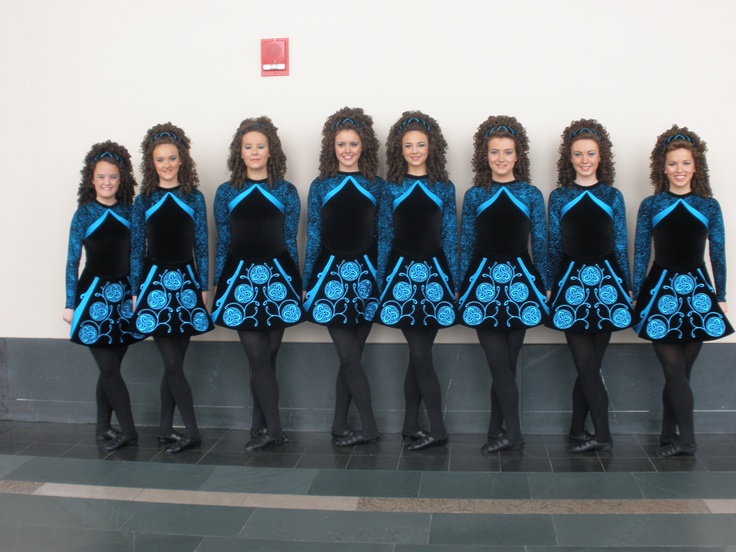 Competition dresses tend to be much more intricate and will require a lot more work.
Competition dresses tend to be much more intricate and will require a lot more work.
Select the design of dress you want. The design should be reflective of the time and money you have to devote to this project. The more simple the design (e.g., less embroidery, repeated patterns) the less the dress will cost. Competition dresses are usually more intricate, so the purpose of the dress might help you decide on a design.
Select the colors and types of fabric you wish to use. If you are making a dress for a specific dance club, maybe the colors have already been decided for you. Competition dresses can generally be any color you want, although most people avoid using more than three colors on one dress.
Find a pattern you wish to follow. One of the most popular patterns for Irish dance dresses is made by Simplicity. This pattern is no longer manufactured and sold in fabric stores, but you can typically find it on online auction sites. Another popular pattern is offered by Irish Threads.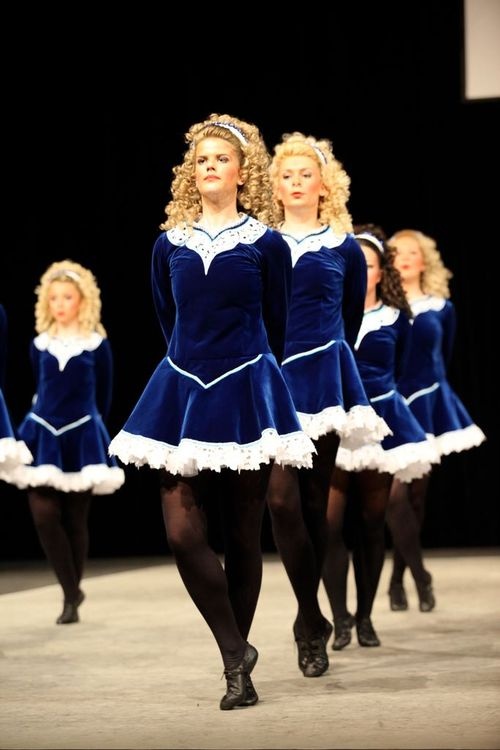 You can find their pattern by visiting the Irish Threads website, and selecting “Dance Dress Pattern” from the menu on the left hand side.
You can find their pattern by visiting the Irish Threads website, and selecting “Dance Dress Pattern” from the menu on the left hand side.
Take the measurements of your dancer. Before you begin to cut the pieces for your pattern, be sure to carefully measure your dancer. If you are making a competition dress for a young dancer, it would be wise to make the dress slightly larger to compensate for growth. Competition dresses are painstaking and expensive to make, and the more use you can get out of them the better.
Attach the pattern to the wrong side of your fabric, and cut out all the pieces of your pattern, labeling each piece carefully. At this point, you might want to complete some of the embroidery work, depending on your design. If you are using stretchy fabric, you should use cotton interfacing to prevent the material from stretching out of shape. Also, any applique the pattern requires should be applied at this time.
Attach the sections of the dress together, starting with the side seams of the skirt. Assemble the bodice together and attach the arm pieces. Now attach the zipper to the back of the bodice; open ended zippers work well for this. Attach the collar (if the pattern has one) or pipe the neckline. Now sew the bodice to the skirt, starting with the front panel, and sew the zipper to the skirt.
Finish the dress by adding accessories such as a Tara brooch or Celtic pins. These are particularly useful because they will attach the sash of the dress to the shoulder with a decorative touch.
Irish dance costume ⋆ Kelteria dance school | Irish dances
19th century costume
At the beginning of the 19th century, male Irish dancers wore trousers or breeches with white stockings, a shirt, black shoes with silver buckles - the prototype of modern hard boots. The costume was complemented by a hat and a dovetail coat.
Girls wore ordinary peasant clothes - shirts and skirts or fitted dresses, decorated their hair with ribbons in the form of flowers or crosses, they could tuck in the hem - so as not to interfere with dancing. On holidays, they wore slightly more elegant evening clothes. nine0005
During the century, peasant clothing changed little. From the moment the Gaelic League was founded, it became necessary to search for a national costume.
20th century Kilt in Irish dance
Pipers in the late 19th and early 20th centuries began to wear a kilt, although there is practically no evidence of the Irish origin of this article of clothing. The fashion for a kilt for dancers came in the twenties and thirties of the last century and almost completely replaced the breeches and trousers from the men's wardrobe. The kilt was combined with a shirt, a wide belt, white high stockings. nine0005
The dancers often wore a small overcoat or tweed jacket, with a rectangular 'large kerchief', the so-called traditional Irish 'brath', attached at the back. Wide belts served not just as an ornament - they were often presented to the dancer as a reward, they were proud of as a status item.
Women's clothing consisted of a white, sometimes light-colored woolen dress with a belt embroidered around the neck with a discreet elegant pattern; a cape with a hood was worn over the dress.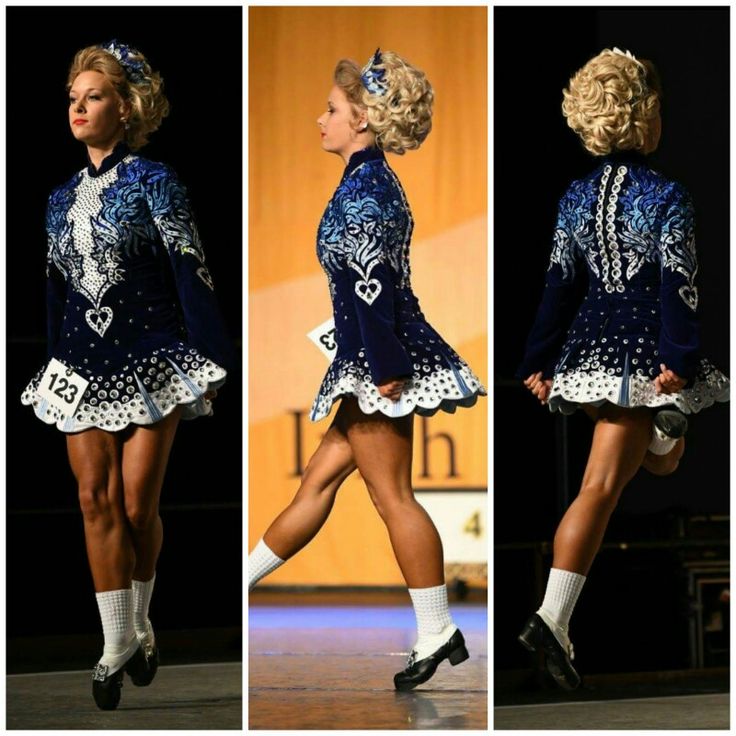 The cloak was sometimes replaced with a shawl embroidered at the corners. nine0005
The cloak was sometimes replaced with a shawl embroidered at the corners. nine0005
By the thirties of the twentieth century, raincoats and shawls were transformed into a small scarf and began to be attached to the back of the suit with brooches or hairpins. Cropped jackets began to be worn over the dress.
Then the jackets disappeared as well, leaving only false cuffs and collars on the dresses. Until the 80s of the last century, they wore beautiful long belts made of cord with tassels.
In special cases, medals received for winning competitions were pinned onto the costumes.
Suit colors
Green, white and dark orange (saffron) are traditional colors in Ireland. In the ancient times of Ireland, the red color was also traditional - the paint was easy to make from local plants, but in the 19th and early 20th centuries, the Irish neglected the red color - it resembled the red uniform of the British invaders.
Over time, the color palette for Irish dance costumes has expanded, at the moment there are no restrictions on the colors of dance attire at all, although men's costumes are traditionally made in more restrained colors.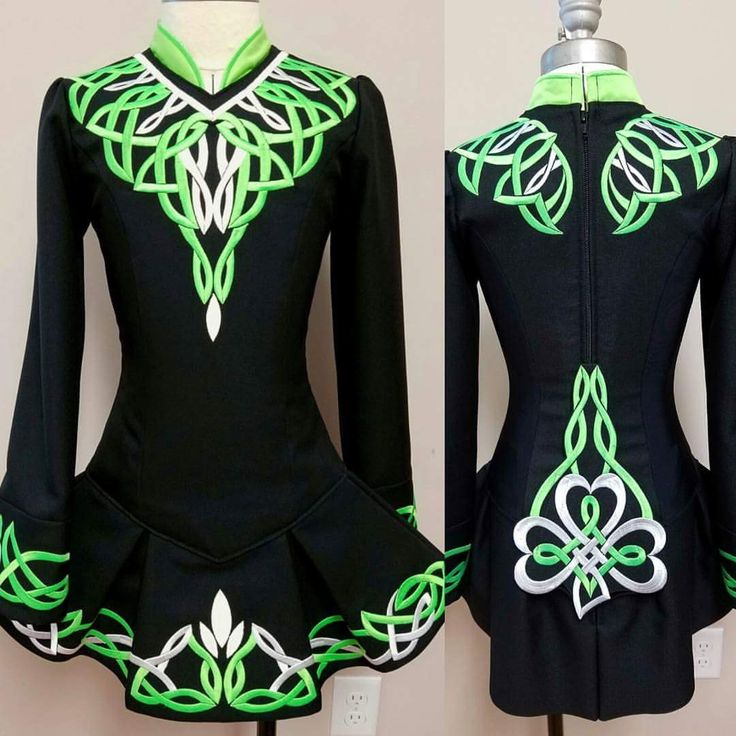 nine0005
nine0005
Embroidery in Irish costume
At the beginning of the 20th century, embroidery on costumes was very modest, but over time, more dense and elaborate patterns and rich decorations began to be used.
Traditional Irish patterns taken from the priceless Book of Kells were used: bowls, stone crosses, woven and solid patterns of complex shapes, symbolizing the eternity of human existence and the continuity of life.
In recent decades, silver and gold threads have been used in embroidery. nine0005
These threads were present in the decoration of women's clothing in pre-Mann Ireland.
Modern Irish Costume
Contemporary fashion designers and artists offer traditional patterns with a modern twist.
The usual attire for male dancers in competitions is dark colored trousers, a brightly colored shirt, tie and waistcoat. The fashion for bright multi-colored ties and shiny vests has already reached the men's wardrobe - and pleases us with diversity.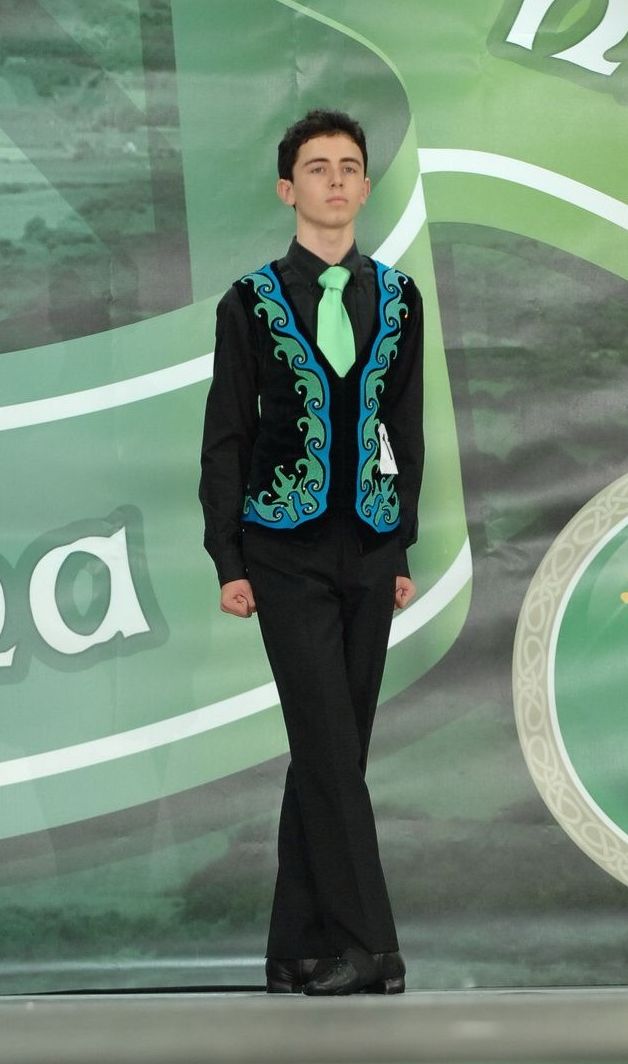 nine0005
nine0005
But the splendor of women's dresses is limited only by the imagination of fashion designers! Modern dresses are short, with a fairly wide skirt, comfortable for sweeping movements.
Solo dresses - bright, multi-colored, with embroidered Celtic patterns, with rhinestones, beads, lurex, trimmed with modern shiny materials.
However, they also dance in more modest dresses, the so-called school dresses, with modest trimmings, but often sewn from velvet.
According to the competition rules, dancers are required to have “genuine Gaelic dress”, but modern costumes are nothing like the clothes of good old Ireland and would have surprised the Celts of past centuries. nine0005
Do it with your feet: who is Irish dancing for?
If you are one of those who like to surprise and stand out, if you like Celtic motifs, if your energy is overflowing, Irish dancing is exactly what you need.
Here is how the head of one of the Minsk schools of Irish dance Yulia Polochanina characterizes them :
Contemporary Irish choreography is a skilful, almost jeweler-like compilation of movements and permutations that combines a bit of step, a touch of flamenco, a pinch of ballet and an endless amount of dynamism and positive.
Plus unique, incendiary motives! nine0005
Sounds exciting, doesn't it?! But it looks the same: bewitching, almost magical!
A distinctive feature of the Irish dance is that during its performance the upper body and arms remain practically motionless . But what tricks the dancers do with their feet! The spectacle is worthy not only to look at it, but also to take a direct part. No slow and smooth transitions, no tearful lyrics - only drive and positive, rhythm and dynamics. nine0005
And just think: the ancestors of this dance are Irish peasants who lived in the XV-XVI centuries . By the way, at that time entertainment events (read - joy and fun) were strictly forbidden for them. But even under pain of death, people managed to gather in crowds in peasant huts, so that the apple had nowhere to fall and dance famously with their feet.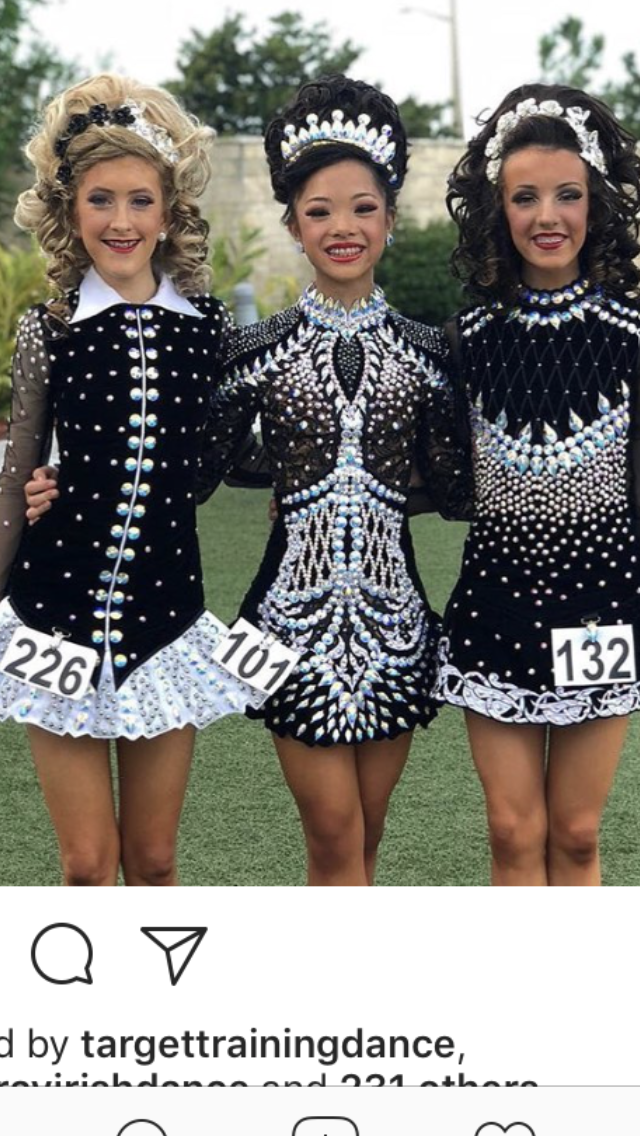
Modern Irish dances, depending on their variety, performed alone, in pairs or in groups (from 4 to several dozen people). Mandatory "brand name" - a colorful suit with symmetrical patterns and ornaments. As well as distinctive shoes made of soft black leather with thin leather soles and characteristic lacing - "Irish" .
If you're just going to dive headlong (or rather, legs) into learning Irish dance, you don't need the equipment of a professional dancer. You can practice in any clothing that leaves your legs open (for example, shorts or a short skirt). First, it's convenient. Secondly, it is necessary so that the coach can control the correctness of your dance movements. nine0057 You can put on at least Czech shoes, at least sneakers, at least sneakers.
But when your level of training is sufficient, to go on stage, you will definitely have to sew a suit (because, alas, you won’t find this in the store) and buy “Irish women”.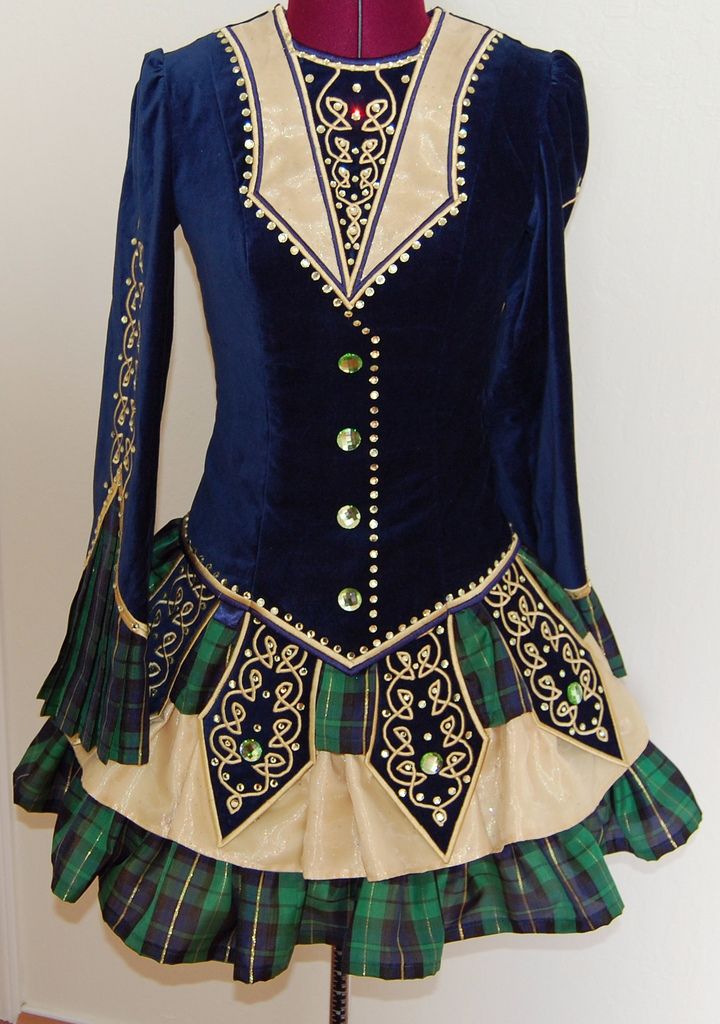 Because this is the case when clothes and shoes are part of the dance itself and make it recognizable no less than the movements.
Because this is the case when clothes and shoes are part of the dance itself and make it recognizable no less than the movements.
And you know what else? You can't learn Irish dancing from master classes on YouTube , you will have to look for a suitable studio or dance school. But on the other hand, this is one of the surest ways to always be in a great mood and have a toned, athletic figure. Because the energy of Irish dance and the abundance of dynamic movements, the need to keep your head straight, your shoulders open, and your stomach drawn in - that's still physical education. As a result, having mastered the art of Irish choreography, you will have as a bonus:
- slender strong legs;
- a straight back and a clear posture;
- beautiful hands;
- figure, like a frequenter of a fitness club;
- the ability to masterfully control your body;
- you will learn to work in a team and it is likely to be a leader.




